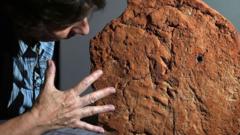What Secrets Does a 4,000-Year-Old Egyptian Handprint Hold?

Unveiling the Past: The Discovery of a 4,000-Year-Old Handprint in Ancient Egypt
In a remarkable archaeological find, researchers from the University of Cambridge have uncovered a 4,000-year-old handprint on an ancient Egyptian tomb offering. This discovery, made during preparations for an exhibition, sheds light on the artisans behind ancient Egyptian crafts, emphasizing the importance of their contributions to history. The handprint, dating back to between 2055 and 1650 BC, was found on a "soul house," a clay model resembling a building, which served an essential function in burial practices. This article delves into the significance of this find, the exhibition it will be featured in, and what it reveals about the people behind ancient Egyptian craftsmanship.
The Significance of the Discovery
Curator Helen Strudwick describes the complete handprint as "a rare and exciting" find, highlighting its uniqueness among ancient artifacts. While traces of fingerprints have been found on various Egyptian objects, a complete handprint is a rarity. This particular handprint provides a direct connection to the potter who created the soul house, a piece that not only serves a functional role but also carries significant cultural importance. Strudwick notes that it is uncommon to see such a well-preserved handprint on an Egyptian object, making this discovery all the more special.
Understanding Soul Houses
Soul houses are fascinating artifacts from ancient Egypt, serving as models of houses that were believed to provide a dwelling place for the soul of the deceased. Typically found in tombs, these clay models often had an open front space where offerings such as food and drink were placed. In the case of the soul house associated with this handprint, it featured loaves of bread, lettuce, and even an ox's head, showcasing the types of offerings made to honor the deceased.
The Craftsmanship Behind the Soul House
The craftsmanship involved in creating soul houses reflects the intricate knowledge and skills of ancient Egyptian potters. Analysis of the soul house revealed that the potter first constructed a framework of wooden sticks, which were then coated with clay to form a two-storey building supported by pillars. This method not only highlights the creative process involved in pottery-making but also illustrates the advanced techniques used in ancient Egyptian craftsmanship.
The Firing Process: A Key to Understanding Ancient Techniques
During the firing process, the wooden framework would burn away, leaving hollow spaces in the clay structure. This crucial step in pottery-making not only solidified the form of the soul house but also demonstrated the ingenuity of the potter. The handprint found underneath the soul house is believed to have been made when the potter moved the piece out of the workshop to dry before it was placed in a kiln for firing. This small yet significant detail provides insight into the daily life and practices of those who created these artifacts.
Highlighting the Makers of Ancient Egypt
The exhibition titled "Made in Ancient Egypt," which opens at the Fitzwilliam Museum on October 3, aims to celebrate the artisans behind ancient Egyptian crafts. While much attention has been given to Egyptian rulers, such as Tutankhamun, the individuals who created the artifacts often remain in the shadows. This exhibition seeks to elevate the status of these craftsmen and provide a deeper understanding of their lives, beliefs, and the cultural significance of their work.
Pottery and Status in Ancient Egypt
According to the museum, the prevalence of pottery and its generally low value may have affected the status of potters in ancient Egyptian society. A text known as the "Teaching of Khet" even compares potters to pigs, suggesting a societal view that may not have honored their craft as much as it deserved. Despite this, the artistry and skill involved in pottery-making are evident in the beautiful and functional pieces that have survived through the millennia.
The Role of Artifacts in Understanding Ancient Cultures
Artifacts like the soul house and the handprint play a vital role in understanding the lives and beliefs of ancient Egyptians. They provide tangible connections to the past, allowing us to glimpse the rituals and practices that defined their culture. The discovery of the handprint adds a personal touch to this narrative, reminding us that behind every crafted object was a person with skills, aspirations, and a unique story to tell.
Conclusion: Connecting with the Past
The discovery of the 4,000-year-old handprint on the soul house not only excites archaeologists and historians but also invites us to reflect on the artisans of ancient Egypt. Their craftsmanship, often overshadowed by the grandeur of rulers and monuments, deserves recognition and appreciation. The upcoming exhibition at the Fitzwilliam Museum promises to reveal more about these skilled individuals, their techniques, and their place in ancient Egyptian society. As we celebrate this extraordinary find, we are reminded that history is not just about the powerful but also about the everyday people whose contributions shaped civilizations.
FAQs
What is a soul house in ancient Egypt?
A soul house is a clay model resembling a building, typically found in tombs, that was believed to provide a dwelling place for the soul of the deceased. It often served as a tray for offerings.
What was the significance of the handprint found on the soul house?
The handprint, believed to be made by the potter, provides a direct connection to the individual who created the artifact, offering insight into the craftsmanship and personal touch involved in ancient Egyptian pottery-making.
How does the exhibition "Made in Ancient Egypt" aim to change perceptions of ancient artisans?
The exhibition seeks to highlight the lives and contributions of ancient Egyptian craftsmen, emphasizing their skills and the cultural significance of their work, which often goes unnoticed compared to the achievements of rulers.
What materials were used in creating soul houses?
Soul houses were primarily made from clay, often over a wooden framework that would be burned away during the firing process, leaving behind a solid clay structure.
Why is pottery important in understanding ancient Egyptian culture?
Pottery provides valuable insights into the daily life, rituals, and beliefs of ancient Egyptians. It reflects their artistic skills, societal values, and the functionality of their objects in both everyday and ceremonial contexts.
As we continue to uncover the stories of the past, what other hidden narratives might be revealed through future archaeological discoveries? #AncientEgypt #Archaeology #CulturalHeritage
Published: 2025-07-28 08:07:11 | Category: technology



